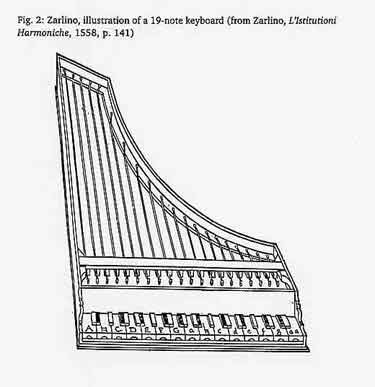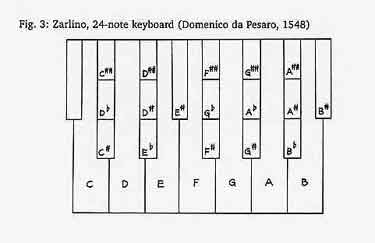ZARLINO'S 24-NOTE HARPSICHORD BUILT BY DOMENICO DA PESARO, 1548
[This text is adapted from my article 'The cimbalo cromatico and other Italian string keyboard instruments with divided accidentals', Schweizer Jahrbuch für Musikwissenschaft N.F. 22 (2003), pp. 112-116. The footnotes follow those of the article.]
Gioseffo Zarlino describes in chapter XLVII of his L'Istitutioni Harmoniche how the theoretical monochord, having been provided with intervals for the diatonic and chromatic genera, can be equipped with enharmonic intervals.[15] He then writes that in instruments equipped to play all three genera the strings are so ordered that each string has a corresponding major third and minor third. After criticising those instruments which have additional notes without any practical use (probably a passing reference to Vicentino's archicembalo) he then continues to relate that in 1548 he had an instrument constructed which would serve for demonstrating harmonies in the realm of music, just as a "touchstone" tests silver and gold.[16] This instrument, built by Domenico da Pesaro, was provided with major and minor semitones which were divided into two parts in such a way [using split sharps] that the whole tone was divided into four parts.
Willi Apel and Lynn Wood Martin appear to have been the first to have correctly reported
the compass as having 24 notes per octave, albeit only in passing.[17] Christopher Stembridge
discussed the instrument in detail and with the assistance of Pesenti's description of the
instrument established that the instrument had a 24-note compass.[18] In the literature it has
mostly been recorded that the harpsichord had a compass with 19 notes in the octave.[19]
Stembridge clarified the problem noting that this confusion has arisen partly because an
illustration appears showing a 19-note division of the octave (fig 2)
.[20]

Zarlino appears to
refer in the 1558 edition to this illustration as the model of harpsichord which could be
constructed by others (...fabricare uno istrumento alla simiglianza di quello ch'io hō
mostrato), but in the 1589 edition mostrato (shown) has been changed to descritto
(described).
However, the misunderstanding is not simply a confusion since Berger argues that Zarlino's
tonal system requires 19 notes.[21]
That Zarlino specifically states the major and minor semitones should be divided into two parts has seldom been mentioned by commentators.[22] If we were to take Zarlino's statement of the 1558 edition literally about dividing the major and all the minor semitones into two parts there could be as many as 31 divisions in the octave, with each tone divided into five parts. A 19-note octave division would suggest dividing the whole tone into three parts. However, the additional information (in later editions) that semitones should be divided in such a way so that the tone should be divided into four parts defines the compass as 24 notes, although it does not tell us which minor semitones should be divided.[23] Thus, part of the inaccuracy concerning the description of this instrument appears to result from scholars consulting the original, 1558 edition which is imprecise in its wording, a vagueness later corrected by Zarlino.
A description of this harpsichord was recorded in 1641 and shows us the notes Martino
Pesenti found (fig. 3).[24]

When we examine the tuning in order to discover which minor semitones
should be divided it appears that Zarlino thought in terms of extending the series of fifths
from B# through to A##, i.e., dividing the small semitones on the "sharp side" of the tone.
We may ask how it was that Pesenti was able to give the exact tuning of the notes. The answer appears to be supplied by Charles Burney's account of finding the instrument in Florence in 1770 in the possession of Signora Moncini: "I copied Zarlino's instructions for tuning it, from his own handwriting, on the back of the foreboard..."[25] The information on the nameboard may also have been the source for Pesenti's claim that this was the first harpsichord made with the diatonic, chromatic, and enharmonic. Whether this instrument still exists is unknown.
NOTES15. Gioseffo Zarlino, L'Istitutioni Harmoniche, Venice 1558, ch. XVLII, pp. 139-142. There were also editions (or printings) with the following dates: 1561, 1562, and 1573, which I have not consulted, but Rudolf Rasch has reported on these in his article "Why were enharmonic keyboards built?" The last revised edition appeared as vol. 1 of De Tutte L'Opere del R.M. Gioseffo Zarlino da Chioggia, Venice 1589. The 1589 edition is set in larger type with the result that page numbers do not correspond with the first edition. In the relevant section of text in ch. XLVII (pp. 170-172) there are a number of minor differences of wording, some of which are discussed below. I am obliged to Christopher Stembridge for a copy of the 1558 edition text at short notice and several discussions of Zarlino's instrument.
16.The simile with the touchstone is in the 1589 edition, but not in the 1558 edition.
17. Willi Apel, Geschichte der Orgel- und Klaviermusik bis 1700, Kassel etc. 1967, p. 476. This reference was found and kindly provided by Riccardo Pergolis; Lynn Wood Martin, "The Colonna-Stella Sambuca lincea, an enharmonic keyboard instrument", in: Journal of the American Musical Instrument Society 10 (1984), 5-21; p. 6, note 4, apparently drawing on Pesenti's description of the compass.
18. See Christopher Stembridge, "The Cimbalo cromatico and Other Italian Keyboard Instruments with Nineteen or More Divisions to the Octave (Surviving Specimens and Documentary Evidence)", in: Performance Practice Review 6 no. 1 (1993), pp. 33-59; pp. 45-46. Martino Pesenti's description of the instrument appeared in the preface to his Corrente, Gagliarde, e Balletti Diatonici, Trasportati...per sonarsi nel clavicembalo & altri strumenti, Venice 1645. Stembridge gives the Italian text and an English translation.
19. A few of the main sources are: Barbour, Tunings, p. 33; Frank Hubbard, Three Centuries of Harpsichord Making, Cambridge, MA. 1965, pp. 32-33, Berger, Theories of Chromatic, p. 51; John Henry van der Meer, "Partiell und vollständig enharmonische Saitenklaviere zwischen 1548 und 1711", in: Das Musikinstrument 36 no. 7 (1987), p. 16; Mark Lindley, "An Historical Survey of Meantone Temperaments to 1620", in: Early Keyboard Journal 8 (1990), 31; my perpetuation of the error in "Harpsichord, 2. The Renaissance, (i) Italy," Early Keyboard Instruments, The New Grove Musical Instrument Series, London 1989, p. 23.
20. See Stembridge, "The Cimbalo cromatico", pp. 45-46. Stembridge inferred that Zarlino's instructions called for a 27-note keyboard, computing the notes necessary to give corresponding major and minor thirds above every string, starting with a compass containing 19 notes per octave.
21. See Berger, Theories of Chromatic, p. 51. This matter will not be discussed here.
22. In the 1558 edition the phrase: "nel quale [in the Clavicembalo] non solamente li semituoni maggiori sono divisi in due parti, ma anche tutti li minori.", Zarlino, L'Istitutione, p. 140 (1558 edition), p. 171 (1589 edition). Sibyl Marcuse, A Survey of Musical Instruments, New York 1975, p. 287, mentions the semitones, as does Kirkendale, Emilio de' Cavalieri, p. 147, and Patrizio Barbieri in his article in this volume, who compares the differences between the two editions. Rudolf Rasch in his article "Why were enharmonic keyboards built?" has also drawn attention to this matter.
23. Kirkendale, Emilio de' Cavaliere, p. 147, provides the text of the 1573 edition which is virtually identical with that of the 1589 edition, p. 171, which latter version is: "nel quale [in the Gravecembalo] non solamente li Semituoni maggiori sono divisi in due parti, ma anche i minori, di maniera ch'ogni Tuono viene ad essere diviso in quattro parti."
24. Stembridge, "The Cimbalo cromatico", pp. 44-55 with Pesenti's Italian text and a correct translation into English. Kirkendale, Emilio de' Cavaliere, p. 147, also mentions this but incorrectly states that Pesenti aquired the instrument, mistranslating the key phrase "quando me capitō alle mani", which Riccardo Pergolis assures me means only that he came across the instrument and was able to examine it. Rudolf Rasch, "Why were enharmonic keyboards built?" discusses the instrument and presents a complete translation of Pesenti's text.
25. Burney, The present state of music in France and Italy, London 1773, p. 253, quoted in Hubbard, Three Centuries, p. 33. Barbieri, "The evolution" (appearing in this volume) corrects the name to Mancini and supplies the information that her deceased husband, Giovanni Battista Pescetti, was 2nd organist at the basilica of San Marco, Venice.